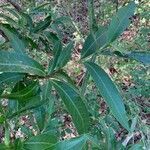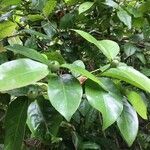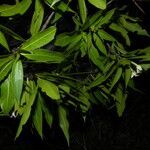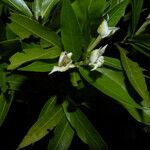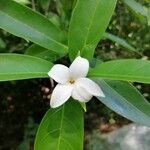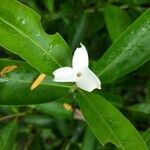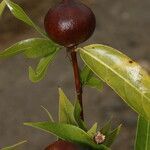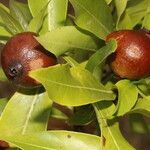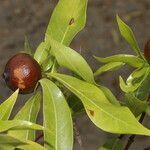Shrubs or small trees, presumably dioecious, the branchlets terete or often ultimately angular, smooth, glabrous, stiffly ascending. Leaves narrowly oblong, falcately oblong, oblong, ovate or rarely obovate-oblong, 6-20 cm long, 2-8 cm wide, deltoid at the apex, acuminate, the acumen to 0.1 cm long, usually acute, deltoid to obtuse at the base; the costa plane to prominulous above, prominent beneath, to 0.2 cm wide, glabrous, the lateral veins 6-15, arcuate, to 2 cm apart, thin-coriaceous, lustrous, glabrous; petioles 0.5-1.0 cm long, rarely absent, gla-brous; stipules connate or free, deltoid, narrowly deltoid or obovate-oblong, ca. 1.5(-2.0) cm long, 0.4-0.6 cimwide, attenuate-acuminate, the acumen often longer than the corpus, scarious, striate-venose, glabrous. Inflorescences of 1 to several terminal flowers subtended' by broadly-ovate bracts shorter than or exceeding the hypanthium in-length, the buds with the apex of the corolla acute and dilated. Flowers sessile; unisexual, the pistillate'-fl-owers solitary, the staminate flowers in a cluster of about 8; hypanthium and calycine cup ca. 0.5 cm long, carnose, glabrous, the teeth 5-4)',' deltoid;to linear, to 1.8 mm long, acute to obtuse; corolla white, the tube 1-3 cm long, glabrous or villosulose outside, subcoria-ceous, the lobes 4-5, imbricate', oblong, to 2 cm long, often exceeding the tube; stamens usually (4-)5(-S8), the anthers narrowly oblong, 5-13 mm long, ca. 13 mm long in male flowers, ca.-5 mm long in female flowers, 0.8-1.0 mm wide, often minutely apiculate, dorsifixedj-thefilaments short, ca. 0.5 cm long; ovarian
More
A small, erect tree. It grows 3-5 m tall. The leaves are shiny green and like avocado leaves. They are papery and 8-25 cm long. Plants are separately male and female. The female flowers are white and occur singly at the end of the branches. Male flowers are in round heads. The fruit is green and similar in size and shape to a pomegranate. They are 2-4 cm long by 2-4 cm wide. Its pulp is black. It is 7-8 cm across. The pulp is fleshy and sweet. There are many angular, flattened seeds. These are 0.5 cm across.
disc doughnut-shaped, occasionally scalloped, 1.0-1.8 mm long, 0.75-1.50 mm wide, the style expanding toward the apex, the stigmas 3-4, crassate, oblong, to 1.8 mm long, the ovary 4-celled. Fruits terminal, sessile, solitary, rotund to com-pressed-rotund, to 3 cm in diam., the persistent calyx coroniform and cylindrical, to 0.5 cm long, rarely to 1 cm long, ligneous, smooth, glabrous; seeds numerous in a slimy pulp, suborbicular, ca. 0.5 cm in diam., striate.
